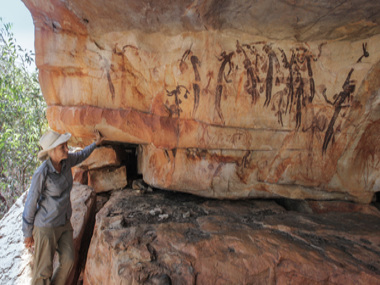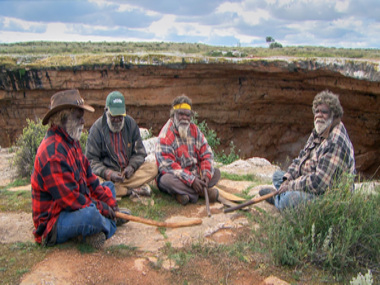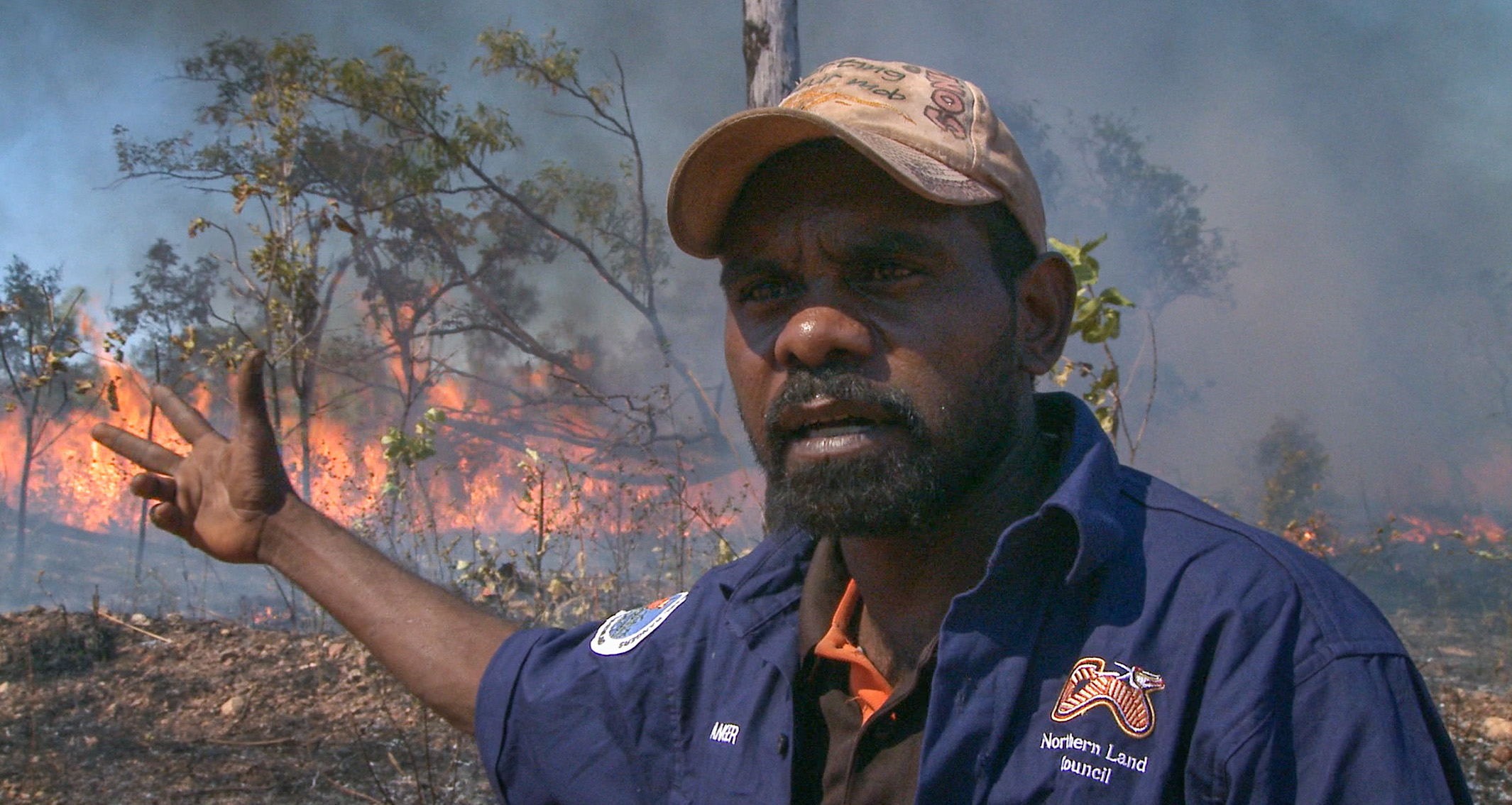THE ABORIGINAL JOURNEY CONTINUES

Dr June Ross withGwion (Bradshaw) Figures at a rock site in The Kimberley
Jeremy Eccles | 26.07.13
Author: Jeremy Eccles
News source: TV Programs
Publication date: 20130714000000
After the marvels of the first two episodes, the ABC's 'First Footprints' makes slightly less impact in bringing Australia up to date through the last 6/7000 years. There are simply fewer firsts than there have already been noted: the First Australians were the first people to leave Africa, the first to leave behind evidence of ceremony, and the first to portray the human face. But it's still a must-watch series – 2 episodes to go.
We do get claims of "the oldest religious story in the world" as Pitjanjatjarra elders recount how a flock of tiny birds stopped the rising seas that were eating into the Great Australian Bite. For over the space of about 2000 years – some of the series' dating is a little variable – the melting ice-caps at the end of the last Ice Age pushed the seas up 130 metres, and bit off huge chunks of the Aussie continent. The Pit men, talking as though it was yesterday not 7000 years ago, swear the Nullarbor cliffs were formed by Ancestral Beings in the shape of Desert Finches sacrficing themselves for humanity's good.
Interpolated by an archaeologist, this is the series' strength – Aboriginal versions of history told on site, old film footage capturing Indigenous life and ceremony in a relatively untrammelled form up to a hundred years ago, and scientific explanation for the accuracy of the legends.
The additional feature in episodes 3 and 4 is the use of early non-Indigenous painting to support assertions about hunting and fishing. Joseph Lycett gets a good run; though John Glover's Tasmanian idylls weren't accompanied by the truth that he was painting Aboriginal life from imagination – the Black Wars had already driven his subjects offshore! Ironically, they were then back on Bass Strait Islands that they'd sensibly deserted 6000 years before. For the ecologically wise residents realised that their landmass had diminished to a point where it was no longer viable to live there.
Back in Northern Australia, the rock art is much older, revealing the world's first images of both ceremony and war. Film-makers Bentley Dean and Martin Butler have kept very level heads in the great Bradshaw/Gwion debate – telling a consistent story that the complex Gwion figures reflect a time of plenty before the seas rose, and subsequent less-High art was created in a time of stress as people forced off the Arafura Plains battled for precious resources in The Kimberley and Arnhemland. The film is fully supported in this by both local Wunumbul leaders embracing the Gwions they once denied, and by archaeologists like Drs June Ross and Paul Tacon carefully using words like "dynamic" and "sophisticated" about the earlier art.
A pity perhaps that no one drew any links to today, when yet more rising waters may well lead to further resource battles.
Even comfortable Sydney may have been the setting of such disputation. We're introduced to the skeleton of Narrabeen Man, possibly a refugee from the flooded Tasman Plains, ritually speared in back and stomach, axed in the head and found beneath a bus stop a few years ago. Gadigal man Alan Maddern is on hand to add local knowledge.
Episode 4 is a giant plug for the excellent Bill Gammage's 2011 thesis, 'The Biggest Estate on Earth'. For his cogent fire-farming theory is accepted holus-bolus, and given credance beyond his own book via a trip to Papua Niugini. There, the earliest evidence of agriculture in the 'gardens' that persist across the islands (and into the Torres Strait) occurred at a time when the seas were rising and cutting the transmission of such ideas off from Aboriginal Australia. Indeed, it's even suggested that the pioneering Melanesians actually domesticated taro, bananas and sugar cane for the world.
Over the newly-risen waters, our Indigenes came up with a project that not only transformed a whole Continent, but gave them plenty of time for both ceremony and play. And it's remarkable how many early references there were by white Australians to the efficacy of fire-farming, which was then totally ignored by people determined to tame this strange new land through imported European methods.
Remarkably, neither Bill Gammage nor the film-makers seem aware of surveyor Thomas Mitchell's comments in 1846 which give the lie to Gammage's view in his book that no one "touched (on) the shattering loss the people of 1788 felt at the land's subsequent mismanagement and destruction". In fact Mitchell wrote:"The extensive burning by natives, a work of considerable labour, left tracts of open forest, which had become green as emerald with the young crop of grass. How natural must be the aversion of the natives to the intrusion of another race of men with cattle: people who recognise no right in the aborigines to either the grass they have thus worked from their infancy, nor to the kangaroos they have hunted with their fathers".
"Poor country, gone wild now", is the contemporary quote from an astute Aboriginal observer in the program.
It's a grand story, sensitively told, though inevitably some things get left out. But 'First Footprints' should be both a stepping stone to all our understanding of this place and its original inhabitants, and on every school curriculum for the future.
ABC 1 is showing the series at 9.25pm on Sunday nights.
Share this:
»  del.icio.us
»
del.icio.us
»  Digg it
»
Digg it
»  reddit
»
reddit
»  Google
»
Google
»  StumbleUpon
»
StumbleUpon
»  Technorati
»
Technorati
»  Facebook
Facebook
Contact Details

Pitjanjatjarra Elders Roy Underwood, Lennard Walker, Ned and Fred Grant at Koonalda Cave in the Nullarbor

Arnhemland Ranger Shaun Namarnyilk is still fire farming today
Further Research
News Tags: ABC TV | Australian archaeology | Bill Gammage | First Footprints | Jeremy Eccles | rock art | Thomas Mitchell
News Archive
- 11.10.17 | RETURN OF MUNGO MAN
- 10.10.17 | TARNANTHI 2017
- 11.08.17 | Natsiaas 2017
- 08.08.17 | ABORIGINAL ART ECONOMICS
- 02.08.17 | SCHOLL'S NEXT MOVE
- 20.07.17 | APY ART DOMINATES THE WYNNE
- 17.07.17 | Anangu Artist Wins $100,000 Prize
- 14.07.17 | The End of AAMU
- 13.07.17 | YOU ARE HERE
- 11.07.17 | ART ACROSS THE COUNTRY
- 11.07.17 | TARNANTHI IN OCTOBER
- 05.07.17 | TJUNGUṈUTJA - from having come together
- 02.07.17 | BENNELONG
- 27.06.17 | JIMMY CHI
- 23.06.17 | Blak Markets at Barangaroo
Advertising

